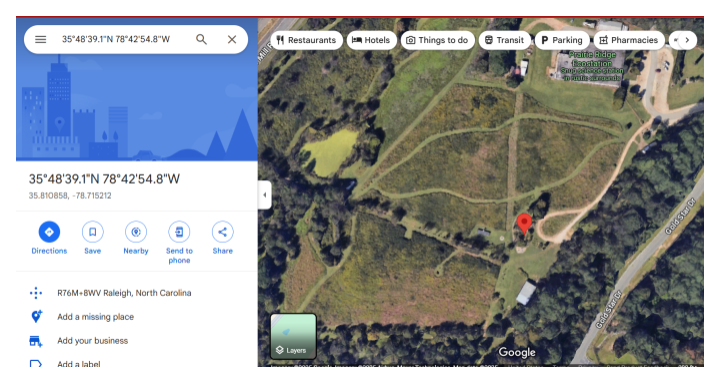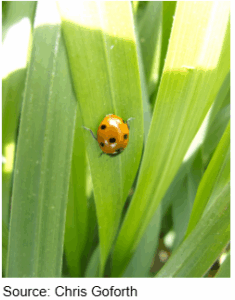Standards + Practices
DCI: LS2.A Interdependent relationships in ecosystems
ESS3.C Human impacts on earth systems
SP4: Analyzing & Interpreting data
Students will look across three data sources (data recording sheets, iNaturalist, and School Grounds Map) to analyze the locations in which ladybugs have (or have not) been found.
SP6: Constructing Explanations
Students will construct explanations regarding the types of locations in which ladybugs have or have not been found on their school grounds.
SP2: Developing and using models
Students will use the mapping feature on iNaturalist to corroborate their findings regarding the habitats in which ladybugs have been found on their own School Grounds Map models.
Resources + Supports

Ms. Jones’ Class Makes Inferences
As her class makes sense of their observation data (ladybug sightings and lack thereof) on where ladybugs have been found, Ms. Jones decides to use this as an opportunity to help students understand the difference between observations and inferences. Ms. Jones facilitates a discussion in which students share observations, which she reminds students are things that they can sense (in this case, see). She records these observations on the left side of a T-chart. She then asks students to consider why they observed ladybugs in these locations and how features of these locations supported their survival; Ms. Jones records these ideas in a column on the right side. After students populate the table, Ms. Jones labels the column “Inferences” and shares that inferences use your knowledge to make sense of your observations. She informs students that as they continue to observe and learn about ladybugs, their inferences may change. Still, she reassures them that what they have generated thus far are the best explanations based on the information they have.


Continuing to Search
How does the presence of ladybugs change across the school year? What might explain those changes?
- Which species of ladybugs do we find at our school? Are they native, non-native, or both?
- What features of our school grounds make the space habitable/uninhabitable for native ladybugs?
How can we improve habitat for ladybugs in our schoolyard?
Repeated searches, even when nothing is found, are important for data collection in participatory science projects. Searching various locations and vegetation provides the opportunity for students to not only collect valuable data, but to also gain a deeper understanding of their schoolyards and patterns in their data. Repeated searches further emphasizes an understanding of the components of their schoolyard system (CCC: System and Systems Models).

iNaturalist Mapping Feature
If locations have been added when observations are uploaded in iNaturalist, you can zoom in on the map provided to see the exact location where a ladybug was found.
- Click on the observation you would like to gather more information about.
- Zoom in on the map provided to the right of the ladybug observation to pinpoint the exact location of the ladybug spotting.
- Click on the “details” underneath the map for more specific information.
- Click on the View in “Google” on the bottom left, which will open up another window where you can view the location in Google maps. From here it is easy to zoom in and clearly view the details of the location.




Pesticide Use
Pesticide use, which kills ladybugs and their prey, may affect the overall insect populations on your school grounds. In addition, the chemicals in pesticides may pose risks to humans (Damalas, 2009), and children may be at greater risk for various diseases associated with pesticide exposure (Kim, et al., 2017). There are other ways to control weeds or invasive bug species, such as liquid soap solutions or integrative pest controls options (See the NCSU IPM for Schools resources for more information). This can all be explored in more detail by your students as a topic for final presentations in the Culminating Activities, if they show strong interest in this topic. You can also assess the option to establish a “no pesticide zone” or “pesticide-free zone” on your school grounds by fencing or marking off an area with signs for the groundskeepers to avoid spraying pesticides in those spaces.
Damalas, C. A. (2009). Understanding benefits and risks of pesticide use. Sci. Res. Essays, 4(10), 945-949.
Kim, K. H., Kabir, E., & Jahan, S. A. (2017). Exposure to pesticides and the associated human health effects. Science of the Total Environment, 575, 525-535.

Writing a Letter
One of the reasons ladybugs might not be found in your school yard is due to groundskeepers’ pesticide use. Ask your administration about who takes care of the grounds at your school, whether in-house or an outside source, and talk to/call/email to ask if pesticides are used, and if so, what kind is being sprayed and where. Encourage students to write a letter (1) to the school groundskeeper(s) to highlight their inferences about finding ladybugs on school grounds or (2) to a local master gardener for advice (https://emgv.ces.ncsu.edu/).

Habitat Change
As the seasons change, so do the microhabitats on your campus. In the spring, you may see an abundance of plants beginning to emerge resulting in a greater chance of finding ladybugs (and other insects). In particular, if there are pollinating plants that ladybugs prefer to take shelter on, or because of the insects they will find on them to eat, more ladybugs will tend to be present (the opposite is true as well–if these plants or aphids are not present, fewer ladybugs will tend to be present). If you want more information on the types of plants that might attract ladybugs, refer to the following site: How to Attract Ladybugs.
Allow students time to consider how microhabitats have changed over the course of the year. After reviewing the mapping feature on iNaturalist, ask students to construct explanations for why ladybugs may or may not have been found in specific locations on your school grounds based on how the microhabitat may have changed since the beginning of the school year.
How might the microhabitats on our school grounds differ since the beginning of the school year?
As the temperatures drop during the fall and winter, vegetation changes. Some trees lose their leaves and plants enter a dormant phase. Aphids may have less plant matter to consume, which in turn creates less prey for ladybugs.
What considerations or features of our school grounds might be important to keep in mind as we look for patterns in data?
Overall location, vegetation present or not present, terrain, pesticide use.

Writing Prompt
Think about the features of the microhabitats where ladybugs have been found on your school grounds. How can you connect the observation data to what you know about microhabitats to determine patterns?
Check student responses for the following:
- Students compare data sources to determine features of the microhabitats (writing about the vegetation at the location as described in each data source).
- Students refer to specific data from data sources as evidence for their explanation.
- Students have considered how the microhabitat is related to the number of ladybugs found.
- Students have considered how the microhabitat is related to the variety of ladybugs found.
- Students describe how reviewing each data source has supported or challenged ideas they already had about microhabitats on your school grounds.

Investigating Others’ Data in iNaturalist
Divide students into groups and assign them a ladybug observation from Ladybugs at School on iNaturalist (not one of your school’s observations). Allow students time to explore the observation, including the identified species, the map feature (see science support above), and observation time stamp. Ask students to collaborate to find patterns in the other observation data related to their own school data. They may need to research additional information regarding the location of this observation (i.e., information about the state/region/location where the ladybug was spotted). Allow groups to generate their own questions and/or share select questions (examples below).
Location
- What region is the other data from?
- What do you know about this region?
- What is the terrain like on your school grounds and the other location?
- What is the weather and climate of the other location? How closely does it resemble the weather and climate of the area where your school is located?
- What makes this location unique?
- What is the elevation of this location?
- Does this location have any challenges that make it more difficult to attract ladybugs? How does the location’s data provide evidence that there are challenges compared to your school?
- Does this other location have any advantages over other locations that make it more likely to attract ladybugs? How does their data provide evidence that there are advantages over your school’s location?
- How does the other location’s data help you support or challenge ideas that you had based on your school’s data?
Microhabitat
- What microhabitats (building, garden, meadow/grass/weed, bushes/shrubs, soil/rocks/sand-not shore, yard/backyard) exist on the school grounds?
- What microhabitats exist in the other location?
- Were more ladybugs found in certain microhabitats on school grounds than other microhabitats?
- Have ladybugs been found at the other location in microhabitats that are similar to the ones our class has found ladybugs in?
- Did the other searchers find a greater amount of ladybugs in the same microhabitats than our class has found?
- Did searchers in the other location find the same variety of ladybug species as our class?
- Did searchers in the other location find particular ladybug species in the same or different microhabitats as our class has?
- Within a microhabitat, are there particular plants where ladybug species have or have not been found?
- How does the data from the other location help you support or challenge ideas that you had about microhabitats based on your school’s data?

In next month’s activities, students will be examining seasonal data to find patterns of ladybug sightings and make comparisons with data sources. As spring vegetation may begin emerging on your campus in March, it may be a great time to get back outdoors for data collection.


